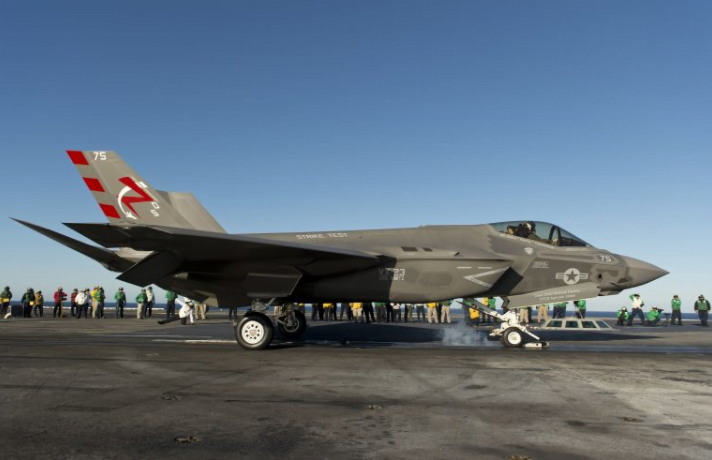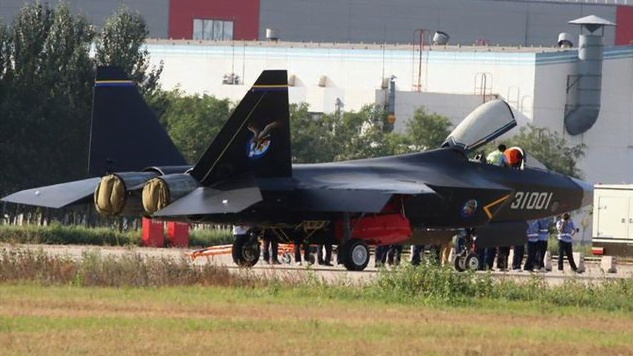Follow Us:
Share
Table of Contents:
Defense Feeds – Today we will review interesting information about China’s J-35 Carrier Fighter, does it a step to the most powerful navy? China’s Navy has taken another step toward erasing the last advantages that the US Navy enjoys, in the form of the new, stealthy carrier fighter aircraft known as the J-35.
It is a fighter jet that China’s military once considered a white elephant appears to have finally secured a role as the country’s newest carrier fighter.

Prior to the introduction of the J-35, the backbone of China’s air force was the J-15 fighter. The J-15 is a reverse-engineered Chinese copy of the Russian Sukhoi Su-33, a fourth-generation fighter which has been thoroughly surpassed by U.S. planes such as the F-22 and F-35.
In fact, the Shenyang Aircraft Corporation has existed as an actual flying platform since 2011, after which it progressed through three major design iterations and several designators (F-60/J-31/ and FC-31) before resurfacing as the J-35 aircraft which features a redesigned wing and an elongated fuselage optimised for a lower radar cross section (RCS).
China’s J-35 Carrier Fighter Appear in Public
The J-35’s first public appearance was as the J-31 at the 2014 Air Show China expo. This model was fitted with two underpowered Russian-made engines originally developed for the Mikoyan MiG-29.
What buzzes our mind is how could china developed the J-35 so fast?
The plane’s success is all the more surprising because the process has been conducted in fits and starts. The first J-35 prototype then called the FC-31 was put on display at China’s 2014 Air Show, but it did not perform well.
Some of its problems were fixed in a second prototype released in 2018, but the increased weight required the development of domestic engines.
One suspicion regarding the remarkable advancement in China’s aerospace program has been predicted that “China cheated”. As mentioned previously that Beijing has acquired a level of technical capability that took the Navy a century to achieve, citing the country’s ability to use both open-source and stolen material to improve its programs.
What happened is China has been caught carrying out such operations before. In 2014, a Chinese national was detained in Canada on suspicion of engaging in cyberattacks, two years later, he pleaded guilty to stealing data on the design of the F-22 and F-35 fighter jets.

China’s J-35 Carrier Fighter Specs
To know more about J-35, let’s take a look on its specification. The jet with the length of 17.3 m has one crew as its pilot. The maximum take-off weight is 28,000 kg and maximum speed of 2,200 km/h with the wingspan of 11.5 m.
Also this aircraft is fitted with the armament of 6 external and internal bay hardpoints with a capacity up to 8,000 kilograms, 12 of medium ranges air to air missiles, 8 of supersonic air to ground missiles, and 8 of 500 kg of deep penetration bombs.
Another question that comes to mind “is it possible if the J-35 as superior as F-35”?
Nobody can deny that the F-35 is one of the most advanced and most capable fighter jets. While its early variants experienced all kinds of problems, the U.S. spent billions of dollars improving this airplane, and many tests and training fights show that it can challenge any other jet.
According to Hawk Carlisle, president and CEO of the National Defence Industrial Association and former commander of Air Combat Command, another major significant points of this aircraft is its sensor fusion, situational awareness and connectivity capabilities.
The F-35 fighter jet has advanced sensor fusion and weapons range and detects, tracks, and destroys enemy aircraft at much greater distances. Thus, it can take out enemy aircraft long before they could get close enough to engage in a dogfight.
What makes the F-35 stand out is its incredible fusion of advanced sensors, stealth, electronic warfare, and networking capabilities. The U.S. spent over $1.5 trillion dollars developing this plane, making it the most expensive weapon platform ever and also the most advanced one.
It is known that Beijing has spent years to develop the advanced, fifth-generation fighter that it believes may supersede US F-35.
According to report on the 2014 US-China Economic and Security Review, cited a 2010 Defence Science Board report stated that the Chinese cyber-espionage led to the theft of US weapons specs, including the F-35.
From this statement, it can be seen that China is known to engage in consistent efforts to steal or copy U.S. weapons platform specs. Certainly, any kind of “F-35-like” maritime power projection presents a substantial threat to the U.S. Navy.
It does not seem at all clear that China J-35 new jet is in any way comparable to an F-35 jet in terms of performance. However, a general external similarity does not in any way guarantee that the aircraft is comparable to an F-35 jet in any capacity.
In regard to the Shenyang J-35, it is China’s first carrier-capable stealth aircraft. The aircraft’s development is significant step forward in China’s domestic aerospace program. Putting the country to become the world’s second-largest aircraft carrier operator.
The fighter J-15 is an improved version of the Shenyang FC-31 Gyrfalcon also known as the J-31. It is a twin-engine, mid-size fifth-generation jet fighter developed by Shenyang Aircraft Corporation.
The official nickname published by Shenyang Aircraft Corporation (SAC) is Gyrfalcon, though it has also been referred to as the “F-60” or “J-21 Snowy Owl” or called “Falcon Hawk” by some military enthusiasts.
What is the projection of China’s J-35 Carrier Fighter for the future?
It is very likely that the J-31 appearing as the J-35 aircraft with a re-configured wing and an elongated fuselage. It will be inducted as a carrier-based naval fighter.
According to China’s state-run media, FC-31’s chief designer Sun Cong expressed that the aircraft would follow his J-15 onto China’s aircraft carriers.
However, officials from AVIC only said that the aircraft was intended for export as a competitor to the F-35. There has also been reports that the PLAAN has urged Shenyang to develop a carrier-compatible version of J-31.
The FC-31 fighter probably isn’t the F-35’s equal, but it’s a significant upgrade from the J-15, and that will make the Chinese Navy delighted. It can be said that China is taking a pragmatic approach to the dangerous and expensive world of naval aviation.
Instead of rushing to match the U.S. Navy from the outset, the country learning to crawl, and then walk, and then eventually run. It’s an approach that’s likely to pay off for decades to come.
Share
Defense Feeds
Defense Feeds is publication focusing on informing, engaging, and empowering the world by providing accurate information from defense technology.
Powered by Defense Feeds © 2025 – All rights reserved.




